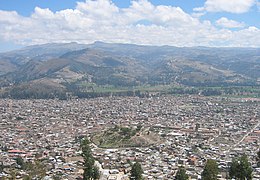Cajamarca
| Cajamarca | |||||
|---|---|---|---|---|---|
Clockwise from top: Partial view of the city, Nuestra Señora de la Piedad Chuch, Santa Catalina Church.
|
|||||
|
|||||
| Location in Peru | |||||
| Coordinates: 07°09′52″S 78°30′38″W / 7.16444°S 78.51056°W | |||||
| Country | Peru | ||||
| Region | Cajamarca Region | ||||
| Province | Cajamarca Province | ||||
| Founded | circa 1450 by the Incas; Spanish settlement in 1532 | ||||
| Government | |||||
| • Mayor | Manuel Becerra | ||||
| Area | |||||
| • Total | 392.47 km2 (151.53 sq mi) | ||||
| Elevation | 2,750 m (9,020 ft) | ||||
| Population | |||||
| • Estimate (2015) | 226,031 | ||||
| Time zone | PET (UTC-5) | ||||
| • Summer (DST) | PET (UTC-5) | ||||
| Area code(s) | 76 | ||||
| Website | http://www.municaj.gob.pe/ | ||||
Cajamarca (Spanish pronunciation: [kaxaˈmaɾka]) is the capital and largest city of the Cajamarca Region as well as an important cultural and commercial center in the northern Andes. It is located in the northern highlands of Peru at approximately 2,750 m (8,900 ft) above sea level in the valley of the Mashcon river. Cajamarca had an estimated population of about 226,031 inhabitants in 2015, making it the 13th largest city in Peru.
Cajamarca has a mild highland climate, and the area has a very fertile soil. The city is well known for its dairy products and mining activity in the surroundings.
Among its tourist attractions, Cajamarca has numerous examples of Spanish colonial religious architecture, beautiful landscapes, pre-Hispanic archeological sites and hot springs at the nearby town of Baños del Inca (Baths of the Inca). The history of the city is highlighted by the Battle of Cajamarca, which marked the defeat of the Inca Empire by Spanish invaders as the Incan emperor Atahualpa was captured and murdered here.
The etymology of Cajamarca may mean 'town of thorns' or 'cold place' depending on the source. All sources agree that the word has quechua origin.
The city and its surroundings have been occupied by several cultures for more than 2000 years. Traces of pre-Chavín cultures can be seen in nearby archaeological sites, such as Cumbe Mayo and Kuntur Wasi.
During the period between 1463 and 1471, Tupac Inca conquered the area and brought Cajamarca into the Tawantinsuyu, or Inca Empire. At the time, it was ruled by Tupac Inca's father Pachacuti.
...
Wikipedia






